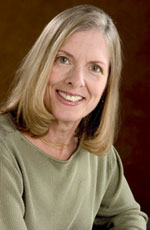Bad Farts? Meat Stinks!

By John McDougall
By about the fourth day of each McDougall Live-in Program participants have become close friends. As they loosen up with each other they begin to discuss one noticeable side effect of my diet. They make jokes, like, “When we walk, we talk,” or “Have you heard a good McBugle lately?” I must admit that one unavoidable change that comes with the diet I recommend is the production of more bowel gas – but that’s not all bad as you will learn when you read this article.
Intestinal gas, called flatus, when released from the lower bowel can be a social problem. On the average gas is passed 10 to 20 times a day, and the volume averages 3 ounces (90 ml) of gas per passage on the usual American diet (range from 17 to 375 ml).1 The average daily volume of flatus is 705 ml (24 ounces) (range of 476 to 1491 ml). At the very lower limit of gas production, a liquid diet devoid of all complex sugars has been found to produce an average of 1.5 flatus passages in 24 hours with a total output of 214 ml/24 hours.2 (Yes! Research dollars actually are spent to study this.) You can safely assume the upper levels in frequency and volume for anyone on the McDougall Program.
Unfortunately, some people avoid a healthy plant-based diet because they have discovered that all that fiber found in plant-foods and especially beans, causes more gas, even though they realize these same foods relieve constipation and irritable bowel syndrome, and help prevent heart disease and cancer. This is just another example of how our decisions about the way others perceive us often are more important than decisions for our health.
I submit two lines of defense for my Program: First, when human beings were designed, millions of years ago, we lived outdoors, with few confining walls – so bowel gas was unnoticeably dispersed into thin air. Second, bowel gasses produced from a plant-based diet are much less malodorous than are those from a diet rich in animal products.
The Business of Flatology:
Flatus, more commonly known as farts, and delicately referred to as “passing wind or gas,” is a source of discomfort and embarrassment for many people, particularly women.3 Flatulence is the condition of the bowels being overdistended with gas. Flatology is the scientific study of flatus. In order to study flatus, dedicated men and women have tubes placed in their rectums, attached to impermeable plastic bags, which they wear all day long to collect the gas. The judges who personally evaluate the odor of the gases with their noses must be especially admired for their dedication to the science of flatology (I’m serious).
Two Main Gas Sources:
1) Swallowed air. Aerophagia is the swallowing of air and is usually followed by eructations (burping). For some people the amount of gas swallowed can cause flatulence. Swallowed air can be determined to be the source of the excess bowel gas by finding a large amount of nitrogen in the flatus sample. About 80% of air is nitrogen. Determining that the excess bowel gas is due to swallowed air, rather than a problem with the bowel itself, can save an expensive and uncomfortable series of tests for the patient.
2) Bowel Produced Gas. The major source of gas in the bowel for almost everyone is the normal metabolic activity of colonic bacteria on our partially digested foodstuffs. Carbohydrates that have not been absorbed by the processes of normal digestion with enzymes in the small intestine are commonly known as dietary fiber. These undigested fibers move into the large intestine (colon) where bacteria break them down by the process known as fermentation into a gaseous mixture consisting primarily of: nitrogen (N2), oxygen (O2), carbon dioxide (CO2), hydrogen (H2) and methane (CH4). These gases are all odorless and colorless. There are also small amounts of odoriferous sulfur-containing substances produced, like hydrogen sulfide, methanethiol, and dimethyl sulfide.
The most common source of undigested carbohydrate in the American diet is lactose from dairy products, such as milk, skim milk, and yogurt (cheeses contain little lactose). The second leading gas-producing foods are legumes (beans, peas, and lentils). Whether they are served as “beans with hot dogs,” or in a “low-fat vegetarian chili,” legumes all cause gas because they contain two relatively indigestible sugars, raffinose and stachyose, that end up in the large intestine.
All unrefined plant foods, including grains, fruits, and vegetables, contain undigestible fibers that end up being fermented in the large intestine by bowel bacteria into odorless gas. Refining grains into white flour and rice removes most of the indigestible carbohydrates (dietary fiber). White rice has been shown to be one complex carbohydrate that is nearly completely absorbed by the small intestine resulting in almost no indigestible carbohydrate for bacteria to turn into flatus.4
The Sulfur Stinks!
The offensive odors of flatus are caused by tiny amounts of sulfur-containing gases. Sulfur gases are detected by our noses in concentrations as low as 1 part in 100 million and are often described as smelling like “rotten eggs.” This may or may not surprise you, but the flatus from women was found to have higher concentrations of hydrogen sulfide and greater odor intensity than from men.5 In a scientific experiment on flatus, odor was rated from 0 (no odor) to 8 (very offensive) by the highly trained noses of two separate judges. Women were rated with an average score of 5.45 and men an average of 3.95. However, men passed higher volumes of gas than did women (119 ml vs. 88 ml/passage). As a result the volume of sulfur gasses in each passage did not differ between men and women.
To make odor matters worse, a large portion of the sulfur that does not leave with the feces and flatus is absorbed through the intestinal walls, into the blood stream where it is excreted in the urine or into the breath and sweat as foul breath and body odor.6 Body odor, as the perfume industry knows well, is a primary source of communication between people, effecting our emotions, and causing feelings of physical attraction (or repulsion) and love.7
Animal Foods Produce Sulfur:
The main source of sulfur in the feces and intestinal gas is from animal foods, and more specifically, the sulfur-containing amino acids found in animal proteins. All proteins in nature are made from the same 20 amino acids arranged in different sequences – just as the 26 letters of the alphabet make up all the words in a dictionary. Methionine, cysteine, cystine, and taurine are the amino acids that contain sulfur in their structure.
Small amounts of sulfur also come from additives and vegetable foods. Inorganic sulfur, as sulfites, sulfur dioxide, bisulfate, or metabisulfite, is used routinely in the preservation of processed foods and beverages – like a common practice in salad bars. Most vegetable foods are low in sulfur, except for a few like garlic, broccoli and cauliflower.
The proof that animal products are the main source of these offensive gases comes from an experiment on five healthy men on 5 different diets for 10 days each.8 The meat intake ranged from 0 grams/day to 600 grams/day (20 ounces). On the vegetarian diet, 0.22 mmol/kg of fecal sulfur material (sulfides) was detected and on the meat diet, 3.38 mmol/kg was found. Therefore, more than 15 times more sulfur was produced with the meat diet, than with the no-meat diet.
Animal products are the main sources of the sulfur-containing amino acids.9 Compare the relative amounts of methionine in these foods (based on calories):
- Beef provides 4 times more than pinto beans
- Eggs have 4 times more than corn
- Cheddar cheese has 5 times more than white potatoes
- Chicken provides 7 times more than rice
- Tuna provides 12 times more than sweet potatoes (Giving a whole new understanding of “fish farts.”)
Sulfur is Also Toxic:
The foul odors of sulfur gases should be a clear message for the perpetrators that something is terribly wrong down below and deserves our immediate attention. These sulfur-containing gasses are extremely toxic to the tissues and they may play a role in a life-threatening inflammatory bowel disease, called ulcerative colitis.10-11
Levels as low as 0.5 – 1.0 mmol/L have shown deleterious effects on the human colon.12 Therefore, small amounts of beef (or the protein in any animal product) can produce levels of sulfur known to be toxic to the cells of your colon.
Gas Solutions:
For people following the McDougall Program, adjustment to the new high-fiber foods occurs in time, and the amount of gas produced diminishes in about 2 weeks. Much of this adjustment comes as a result of changes in kinds and numbers of bowel bacteria.13
Avoid Gassy Foods: Milk products are troublesome for most non-Caucasian people (Asians, Blacks, Hispanics, Indians, Eskimos, etc.) who can’t digest lactose; about 20% of Caucasians also have this trouble. All legumes–beans, peas, lentils, etc. – bother all races of people indiscriminately. You do not need to consume beans on the McDougall diet – all the protein you need comes from the other less gassy starches and vegetables you may choose. Some individuals notice trouble with onions, bagels, pretzels, prunes, apricots, cabbage, carrots, celery, green peppers, broccoli, cauliflower, bananas, Brussels sprouts, and wheat germ. But this list of offenders depends on personalized sensitivities and, therefore, could incriminate almost any food.
Become a Pure Vegetarian: With the elimination of all animal products the primary source of the offensive odors – the sulfur-containing amino acids – is removed.8 Within a few days you could change from “silent but deadly” to “still silent but lightly fragrant.”
Thorough cooking: Almost everyone seems to have a method of “de-gassing” beans. Many cooks claim to have inherited the secret process from an authoritative grandmother. Thus, I’ve heard some say “add potatoes to beans during cooking,” or “soak beans first, then discard the rinse water.” Our personal experience has been these methods are of no benefit. Soaking helps, whether or not you discard the original rinse water, simply because soaking starts the breakdown of the carbohydrates and assists cooking. Thorough cooking helps by breaking down indigestible complex carbohydrates into simpler, more digestible forms. Even though cooking will break down many of the gas forming complex carbohydrates found in grains and vegetables, the ones in legumes are heat stable and resistant to cooking.14 However, germination (sprouting) for 1 to 4 days results in utilization of the bulk of these legume sugars.15
Sprouting beans: One reliable way to “de-gas” legumes is to sprout them first. Cover beans with water for 12 hours, drain off water, lay damp paper towels on the bottom of a baking dish, spread out beans on the moist towels in a single layer, and then let them sprout for the next 12 hours. When you notice tiny white shoots (1/16″) beginning to appear they are ready to cook. The tiny plant is utilizing the indigestible sugars for growth.15 Needless to say, beans will take less time to cook after sprouting.
Beano: A product on the market, Beano, in the form of liquid drops and tablets, contains enzymes that are capable of breaking down the indigestible sugars in beans, peas, and lentils. You add a couple of drops to the first bite of food and then you can eat the rest without the problem of bowel gas.16 (Or so the label says ….) We do not use the actual brand Beano because it is derived from fish. Choose other “vegan” products with the same enzymes (such as Vegan-zyme, a digestive enzyme brand with the active ingredient, alpha-galactosidase).
Activated Charcoal: Activated charcoal has been used to treat intestinal gas in India and Europe for many years, and has only recently been gaining acceptance in the United States. In the laboratory, activated charcoal was found to bind and deactivate sulfur gases. Unfortunately, this benefit was not found when human subjects were asked to take 0.5 grams of activated charcoal four times a day.17-18 This failure is probably because all of the active binding sites on the charcoal are filled with substances in the feces long before the charcoal reaches the large intestine where the sulfur gas is present.
Pepto-Bismol (Bismuth subsalicylate): Four tablespoons (524 mg) four times a day for 3-7 days produced a greater than 95% reduction in fecal hydrogen disulfide release.19 (Pepto-Bismol contains substances similar to aspirin which may cause problems in those who have warnings to stay away from aspirin.)
Avoid Medications: Acarbose for diabetes, and lactulose for constipation can cause flatus because they cause an increase in sugars in the large intestine. Many other medications are also known to cause flatulence and therefore any medication should be suspect if you notice a problem with excess bowel gas after starting a new medication.
Probiotics: A change in the kinds of bacteria in the large intestine – the intestinal microflora – can result in a reduction in flatus. In a controlled study, volunteers with irritable bowel syndrome (IBS), were fed a drink with Lactobacillus plantarum – a friendly form of bowel bacteria – for four weeks. Flatulence was rapidly and significantly reduced in the test group compared with the placebo group (number of days with abundant gas production was 6.5 before and 3.1 after the intervention for the test group vs. 7.4 before and 5.6 after for the placebo group).20
Antibiotics: Nonabsorbable antibiotics (like Rifaximin) which kill the anaerobic gut bacteria can reduce the amount of flatus and improve symptoms in very gassy people as a last resort effort.21
My advice: Meat makes farts stink – become a pure vegetarian. Gas is natural – have you ever ridden a horse? Enjoy the gas. The horse seems to.
References:
1) Levitt M. The relation of passage of gas an abdominal bloating to colonic gas production. Ann Intern Med. 1996 Feb 15;124(4):422-4.
2) Tomlin L. Investigation of normal flatus production in healthy volunteers. Gut. 1991 Jun;32(6):665-9.
3) (For a complete discussion of flatus terminology visit:http://www.sillyjokes.co.uk/fart_machine/fart_slang.html.)
4) Levitt M. H2 excretion after ingestion of complex carbohydrates. Gastroenterology. 1987 Feb;92(2):383-9.
5) Suarez F. Identification of gases responsible for the odour of human flatus and evaluation of a device purported to reduce this odour. Gut. 1998 Jul;43(1):100-4.
6) Sabry ZI. Relationship of dietary intake of sulphur amino-acids to urinary excretion of inorganic sulphate in man. Nature. 1965 May 29;206(987):931-3.
7) Marchand S. Odors modulate pain perception. A gender-specific effect.
Physiol Behav. 2002 Jun;76(2):251-6.
8) Magee EA. Contribution of dietary protein to sulfide production in the large intestine: an in vitro and a controlled feeding study in humans. Am J Clin Nutr. 2000 Dec;72(6):1488-94.
9) J Pennington. Bowes & Church’s Food Values of Portions Commonly Used. 17th Ed. Lippincott. Philadelphia- New York. 1998.
10) Levine J. Fecal hydrogen sulfide production in ulcerative colitis.
Am J Gastroenterol. 1998 Jan;93(1):83-7.
11) Roediger W. Sulphide impairment of substrate oxidation in rat colonocytes: a biochemical basis for ulcerative colitis? Clin Sci (Lond). 1993 Nov;85(5):623-7.
12) Christl S. Effect of sodium sulfide on cell proliferation of colonic mucosa. Gastroenterology 1994; 106:A664 (abstr).
13) Gorbach SL. Bengt E. Gustafsson memorial lecture. Function of the normal human microflora. Scand J Infect Dis Suppl. 1986;49:17-30.
14) Oboh H. Effect of soaking, cooking and germination on the oligosaccharide content of selected Nigerian legume seeds. Plant Foods Hum Nutr. 2000;55(2):97-110.
15) East JW. Changes in stachyose, sucrose, and monosaccharides during germination of soybeans. Crop Sci. 1972;12:7-9.
16) Ganiats TG. Does Beano prevent gas? A double-blind crossover study of oral alpha-galactosidase to treat dietary oligosaccharide intolerance. J Fam Pract. 1994 Nov;39(5):441-5.
17) Suarez F. Failure of activated charcoal to reduce the release of gases produced by the colonic flora. Am J Gastroenterol. 1999 Jan;94(1):208-12.
18) Potter T. Activated charcoal: in vivo and in vitro studies of effect on gas formation.
Gastroenterology. 1985 Mar;88(3):620-4.
19) Suarez F. Bismuth subsalicylate markedly decreases hydrogen sulfide release in the human colon. Gastroenterology. 1998 May;114(5):923-9.
20) Nobaek S. Alteration of intestinal microflora is associated with reduction in abdominal bloating and pain in patients with irritable bowel syndrome. Am J Gastroenterol. 2000 May;95(5):1231-8.
21) Stefano M. Non-absorbable antibiotics for managing intestinal gas production and gas-related symptoms. Aliment Pharmacol Ther. 2000 Aug;14(8):1001-8.
Some web sites to expand your understanding of flatus:http://www.heptune.com/farts.html
http://users.utu.fi/s/snapir/fart/
Recommended Articles

Recipes from the August 2006 Newsletter

Recipes from the February 2007 Newsletter






